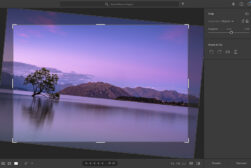
Lightroom Classic vs Lightroom CC – Compare & Understand their Differences
Our easy-to-follow guide to Lightroom Classic vs Lightroom CC. Get to know the difference and pros and cons of each to find which app is right for you.
If you’re just starting out in photography or are looking to take your photo organization to the next level, you may be confused at the differences between Lightroom Classic and Lightroom CC.
For years, Adobe Lightroom has been both the amateur and professional photographer’s go-to program for start-to-finish photo editing and organization.
Now, however, there are 2 versions of Lightroom, with both tied to the Adobe Creative Cloud-based subscription model – the ‘CC’ stands for Creative Cloud.


Great features, regular updates, cloud storage, multi-device functionality - the Photography Plan is the most popular way to get Lightroom.
Formerly known as Lightroom Classic CC and Lightroom CC, here in 2023 they are known simply as Lightroom Classic and Lightroom. For the sake of clarity in this guide, we refer to the latter as Lightroom CC.
Both programs do photo editing and organization, but beyond that, they’re quite different.
Which one you choose will really depend on your workflow, what device(s) you tend to edit on, and how versatile you need the software to be.
Let’s take a look at the main differences between Lightroom CC and Lightroom Classic so you can better understand how and when to use each one to your advantage in 2023.
Lightroom CC vs Lightroom Classic
What is Adobe Lightroom Classic?

Lightroom Classic – desktop-based software
Lightroom Classic is the version that’s been around since the software’s inception in 2007. It functions like a traditional desktop app and stores information about your images in a catalog file that’s separate from your image files.
Your image files can be stored anywhere, but are usually kept on your computer’s hard drive or an external drive.
For photographers, Lightroom Classic has everything you might need to manage a massive library of images on your hard-drive(s), edit them, and then print them. It also allows you to create books, slideshows and web galleries.
There are separate modules for organizing, developing and printing, with everything you need to take an image from import to export on any level.
Other somewhat lesser-used modules include Map, Book, Slideshow and Web, but it’s the core editing and organizing modules that usually get the most use.
While it is desktop-based, you can sync photos via a Creative Cloud subscription with the cloud-based version (Lightroom CC).
See our full review of the desktop version of Lightroom here.
What is Adobe Lightroom CC?
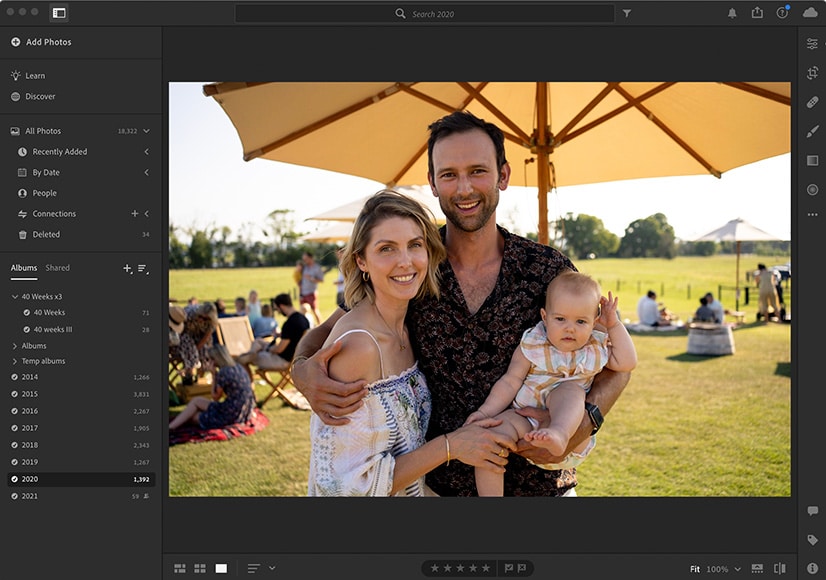
Lightroom (CC) – cloud-based software accessible via multiple devices
Lightroom CC was designed for photographers who want to access to their images online and on various devices, while at the same time have powerful editing and organizing tools at their fingertips.
By default, everything in Lightroom CC is stored in the cloud – not on your device or computer. That means your files are accessible from any anywhere there’s high-speed internet.
One source of confusion for beginners is that while Lightroom CC is cloud-based, it also resides on your computer – it’s best to think of it more as an ‘Internet browser’, providing access to your images which aren’t actually stored locally.
The interface is a lot more streamlined than the desktop software, but on the flip side, it has far fewer options for importing, exporting, and in some cases, editing.
The key benefit with Lightroom CC is its ability to be used via the smartphone and tablet apps – any edits started on one device can be continued on another. See our full review of Lightroom CC Mobile here for more.
Key Differences between Lightroom CC and Lightroom Classic
While both programs allow you to work on images from start to finish, they have some very key differences, and Adobe actually suggests that you choose one over the other.
1. File Storage
Obviously, the first difference is where your images and image information are stored.
Lightroom Classic has everything stored locally – you basically need to have your storage device (computer, external hard drive, etc.) with you to work on your images.
For people who prefer to edit on their desktop or laptop, this isn’t a problem. If you’re on the go, however, and/or need to access your images from a number of devices, this could be a bit of a headache.
That’s where Lightroom CC comes in.
With everything stored in the cloud, high-quality versions of your images are always available without having to download large files onto whatever your device. You can use Lightroom CC to view and edit the images and have everything synced together.
Also, because your images are stored on Adobe’s servers, they’re automatically backed up regularly. With LR Classic, there’s no automatic backup of the files. You’re responsible for that yourself.
2. Interface
Lightroom Classic comes with a comprehensive tool-set, all organized into different modules.
While most folks primarily use the Library and Develop modules, there are also options for creating a web gallery, printing a photo book, making prints, building a slideshow, and viewing geotagged photos on a map.
While all of these features add a huge amount of functionality to Classic, they also create a rather steep learning curve.
If you’re a beginner, you’ll probably need to watch a number of tutorials to really harness the power of Lightroom Classic. In fact, you could be working with Lightroom for years and not know the half of what it can do.
If you’re struggling to work out its best features, check out these Lightroom Tips for starters.
In comparison, Lightroom CC is really quite intuitive.
The interface is meant to be easy to learn and plenty of help has been programmed into the app itself.
They’ve ditched the Classic modes and opted instead for a simple screen that starts out with just your rows of synced photos.
The organizing tools are hidden behind an icon on the left and the adjustment tools behind an icon on the right.
There are hover-over icons explaining each feature and there are optional built-in tutorials that can walk you through a step-by-step process.
Basically, it starts out simple and then reveals more complex tools as you need them.
3. Editing
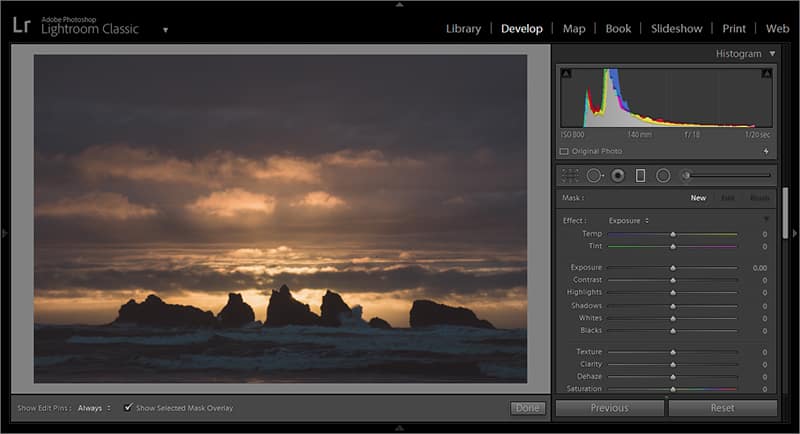
Image editing in Lightroom Classic is extremely powerful.
In the beginning, Lightroom CC really was a paired down version of Lightroom Classic. Now, more current versions almost have editing potential on par with Classic.
As of the February 2019 update, Lightroom CC gained the HSL panel, split toning, and tone curves, as well as Panorama, HDR, and HDR Panorama capabilities. These were all key equalizers.
Still, a few of the adjustment tools are more advanced in Lightroom Classic. For example, Lightroom CC doesn’t have color and luminance masking, which are fairly new additions to Lightroom Classic. It also doesn’t have as flexible batch-editing features, which are important when editing large volumes of images.
It’s also not compatible with any third party brushes nor any saved settings for your own brushes (you can store them but not export them).
There’s also no history panel, which is a key element in my own editing. There’s also no current ability to use 3rd party plugins with Lightroom CC, but you can thankfully use presets.
These won’t be features beginners will miss, but if they’re part of your workflow, you’re going to need them.
Fortunately, both versions allow the use of Smart Previews, meaning you can save a ton of space on your local hard drive or in the cloud.
4. Importing and Exporting
When you look at the functionality of Lightroom CC and Lightroom Classic, importing and exporting is one place where the rubber hits the road.
Lightroom Classic has copious import and export capabilities.
While importing, you can save to an external hard drive, apply presets, exclude some images and folders from the import, etc. Classic also has a number of export options: file type, ppi, open in another program after it exports, etc.
Lightroom CC, on the other hand, is still very barebones both in its import and export capacity.
Importing has next to no options in CC – for example, you can’t apply any presets or keywords upon import.
For exporting, your only choices are between a larger file and a smaller file. That’s it. You can’t choose what kind of file type your image exports as.
There are also no print options.
That being said, the app version of Lightroom CC can automatically upload anything shot on the phone to your Lightroom cloud storage, and you can search, filter, and tag your photos.
This works great for those into mobile phone photography (though admittedly not for the rest of us).
5. Image Organization and Search
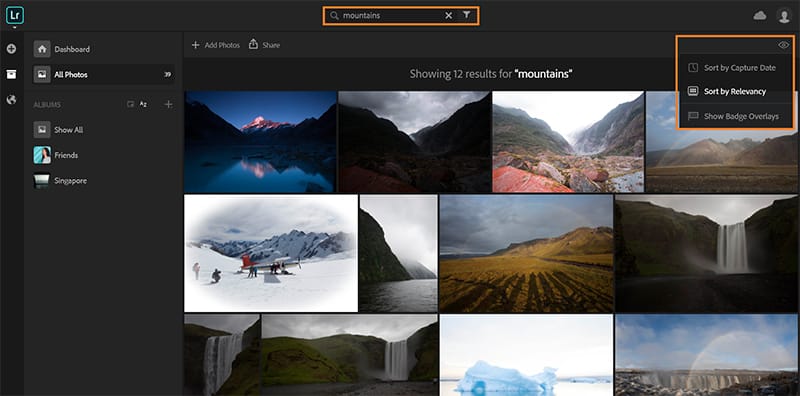
Image search in Lightroom CC is excellent.
While both programs have formidable image search and organization abilities, they’re also a bit different from each other.
The biggest difference is that Lightroom CC uses AI (Adobe Sensei) to let you find particular objects. It also has a surprisingly efficient face recognition algorithm, which is a huge boon to group photographers.
Beyond that, you can search by camera model, keyword, or location.
Lightroom Classic, while not having AI keywording or search (yet), still has more advanced filtering options – you can search by lens, focal length, F-stop, or even ISO.
I’ve actually needed to search by lens multiple times, so this is feature is particularly helpful for me.
Also, one thing Lightroom CC does not have that will be essential for some photographers is Smart Collections (see guide). If you need these for organizing, you’ll be out of luck with Lightroom CC.
Which Version of Lightroom to Choose?
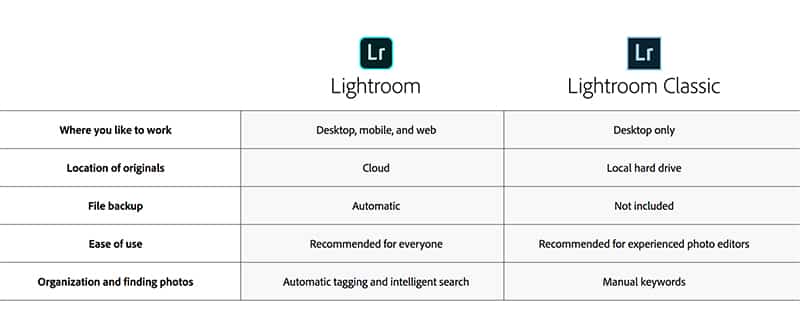
Features comparison of Lightroom CC (left) and Lightroom Classic.
Ultimately, when it comes to Lightroom CC and Lightroom Classic, the right version for you will come down to just a few factors:
Choose Lightroom Classic if:
- you don’t have reliable access to a fast internet connection
- you’re accustomed to older versions of Lightroom (e.g. not Lightroom CC) and you want to retain your workflow
- you want Lightroom Classic’s full suite of advanced tools
- you want full control over your files – where they’re stored, how they’re backed up, etc.
- you work primarily on your desktop or laptop
- you need your files exported as something other than JPEG
- you work with large amounts of images and don’t want to pay for cloud storage
- you frequently print photos or create slideshows
- you frequently use Smart Collections
- you need geotagging
Choose Lightroom CC if:
- you’re a casual shooter or mobile photographer who just needs decent editing tools
- you prefer to store your images in the cloud and/or you want your work to be synced to the cloud
- you want your images available on a variety of different devices
- you’re new to Lightroom and don’t want a steep learning curve
- you don’t want to put much thought into your file storage, organization, or backing up your files
- you need CC’s AI object search or face recognition
Fortunately, of course, both versions of Lightroom are included when you sign up to one of the Adobe Creative Cloud Photography Plans.
Pricing
Adobe offers three different plans for Lightroom users:
#1 | Photography Plan + 1TB of Cloud Storage (Recommended)
This is what I use. It’s a great value option if you only need Lightroom and Photoshop, and includes:
- Lightroom CC
- Lightroom Classic CC
- Photoshop CC
- Full Lightroom Mobile Functionality (including the 8 Premium Features)
- Your own portfolio website and social media tools
- 1TB of cloud storage (about 20,000 raw DSLR images or 200,000 JPEGs)
- One month of free Adobe Stock
#2 | Photography Plan + 20GB of Cloud Storage
This option is for users who don’t plan to take full advantage of Lightroom CC and all its cloud syncing features. 20GB allows you to only store approximately 400 RAWs or 4,000 JPEGs.
- Lightroom CC
- Lightroom Classic CC
- Photoshop CC
- Full Lightroom Mobile Functionality (including the 8 Premium Features)
- Your own portfolio website and social media tools
- 20GB of cloud storage (about 400 raw DSLR images or 4,000 JPEGs)
- One month of free Adobe Stock
(You can also opt for the basic Creative Cloud Photography plan with only 20GB of storage. However, I don’t recommend this option since it doesn’t allow you to take full advantage of Lightroom CC’s cloud syncing features.)
#3 | (Best Value For Power Users) Creative Cloud All Apps
This is Adobe’s most popular option, and perfect for photographers who also need regular access to other Adobe apps. It includes:
- The entire collection of 20+ creative desktop and mobile apps including Photoshop CC, Lightroom CC, Illustrator CC, and XD CC
- 100GB of cloud storage, your own portfolio website, premium fonts, and social media tools
- Up to 10TB of cloud storage
- One month of free Adobe Stock
(If you’re a Student or a Teacher, you can get the CC All Apps plan for up to a 70% discount using this link.)
Final Words
Ultimately, while Lightroom CC is the preferred software for photographers that want to edit anywhere, Lightroom Classic is still the default that most pros use.
Still not sure which to choose? Luckily you don’t have to. Although Adobe recommends that you choose just one, under the Photography Plans, you could conceivably use both… which is what many photographers in 2023 actually do.
Which works best for you and why? Let us know!


Great features, regular updates, cloud storage, multi-device functionality - the Photography Plan is the most popular way to get Lightroom.










